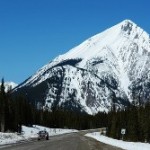Here we are in the midst of the holidays and many of us are planning to drive to the mountains to enjoy the snow or set out across the country to visit relatives. Whatever your plans are this winter season we want you to drive and arrive in safety. Even though the weather has been beautiful here in our area, we all know that it only takes a moment for it to change! We all need to know winter driving safety tips. To accomplish this we are sharing ten tips for winter driving from the publisher of RoadTrip America. 
- Know your route and keep abreast of weather conditions. Make a list of Department of Transportation road-condition hotlines and consult them every few hours while you’re on the road. Pay special attention to avalanche conditions along your route, because temporary road closures are common in mountain areas. The Web is also a good source of current weather information.
- Drink plenty of water. When the weather is chilly, dehydration seems unlikely, but according to a study by the Mayo Clinic, as little as a 1-2% loss of body weight can lead to fatigue and reduced alertness, which are both deadly when driving in winter conditions. Carry five to six, 16oz. bottles of water per day. Keep them with you in the passenger compartment, as they might freeze in the trunk.
- Eat enough food. Your body needs more nourishment in cold weather than it does on a balmy summer day. Avoid candy bars and other quick-sugar-release snacks. Sandwiches, fruit or a thermos of stew are much better choices. Carry a day’s worth of high-energy food and water in a warm area of your car in case you are stranded for a few hours.
- Pack a winter travel safety kit. Include a cell phone, an ice scraper and brush, a tow rope, cat litter(as a traction aid), blankets, a good flashlight, a candle, matches, a portable weather radio and a can of lock de-icer. Never use hot water on glass or locks- it will refreeze and create a bigger problem.
- Slow down. A good rule of thumb is to reduce speed by 50% in snowy conditions. Blasting through snowdrifts may look cool on TV, but it’s way too hard on your vehicle to be worth it. Equally important: Don’t go too slow. Your car needs momentum to keep moving through snow on grades.
- Keep a light touch on the controls. Smooth operation is the key to keeping control in slippery situations. Nervousness can lead to a hard clench of the steering wheel, which can result in loss of control. Consciously loosen your grasp or stretch out your fingers from time to time to help prevent that white-knuckled grip.
- Know how to recover from skids. When braking on a slippery road, it’s all too easy to “lock up” your wheels by stepping on the brakes a little too hard. If you start to skid, steer the vehicle gently in the direction you want the front of your vehicle to go and don’t touch your brakes.
- Keep tires in good condition and properly inflated. Cold weather reduces tire pressure, so check and adjust frequently.
- Make frequent rest stops. Winter driving is much more tiring than summer cruising, so stop every hour or so. Get out, stretch, it only takes five minutes to improve your level of alertness.
- If you get stuck, stay in your vehicle. Stay warm and wait for assistance. Make sure that your exhaust pipe is clear of any obstructions, including snow and ice; if you don’t, carbon monoxide gas can build up inside the vehicle.
Winter driving is a challenge but if you follow these tips you should be able to meet the challenge and win!
